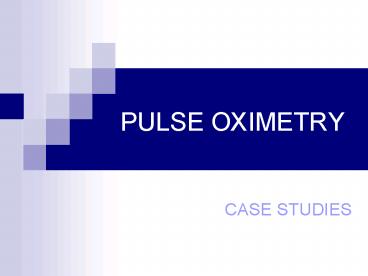PULSE OXIMETRY - PowerPoint PPT Presentation
1 / 24
Title:
PULSE OXIMETRY
Description:
History of diabetes mellitis, coronary heart disease, ... Precordial/Esophageal stethoscope. Blood Pressure cuff. EKG. Capnometer. Radial catheter for ABG ... – PowerPoint PPT presentation
Number of Views:296
Avg rating:3.0/5.0
Title: PULSE OXIMETRY
1
PULSE OXIMETRY
- CASE
STUDIES
2
CASE 1 Methemoglobinemia and its
Effects on Pulse Oximetry
- Cited from Critical Care Medicine Journal
- July 1991
3
Patient History
- 61 y/o white male
- History of diabetes mellitis, coronary heart
disease, peripheral vascular disease, COPD,
colonic polyps, and dermititis herpetifromis - Scheduled to undergo DISTAL FEMORAL ARTERY BYPASS
SURGERY
4
Examination Findings
- Pulmonary Function mild obstructive ventilatory
insufficiency - ABG pH 7.40
- PaO2 74mmHg
- PaCO2 37mmHg
- SaO2 78
- CarboxyHb 1.9
- MetHb 10.0
5
- After the patient is intubated and 100
Oxygen is delivered, the pulse oximeter is
displaying a percentage saturation of only 85. - QUESTION 1
- What action should be taken?
6
Answer 1 An ABG should be taken
- The new readings indicate a SaO2 of 99 with
metHb level of 13.3 - The patient appeared dusky and the sample taken
was dark in color - Question 2
- What are the normal values for MetHb?
- What about CarboxyHb?
7
Answer 2 Normal ranges for all types of Hb
- Met Hb 3
- CarboxyHb 3(but can be as high as 15 in
smokers) - Question 3
- Why does this error occur when excess MetHb is
present?
8
Graph 1
- MetHb absorbs strongly at 660 and 940nm
9
MEDICATIONS THAT CAUSE METHEMOGLOBINEMIA
- Nitrates
- Sodium Nitroprusside
- Phenacetin
- Sulfates
- Lidocaine
- Cetacaine
10
CONCLUSION
- It is important as practitioners that we
understand the limitations of the devices we
choose in order to avoid inappropriate therapy,
as well as our alternative approaches in the
incident that these limitations occur.
11
CASE STUDY 2 Use of Pulse-ox in New
SaO2-oriented technique for Bronchopulmonary
Lavage
- Cited in Chest Journal, November 1991
- The term Bronchopulmonary Lavage
- The washing out, or cleansing of the air
passages (bronchi) as well as the lungs
12
Patient Presentation
- 52 y/o female weighing 53kg
- Suffers from alveolar proteinosis
- Has previously undergone bronchopulmonary lavage
18 times in the past 6 years - She is seeking the new SaO2-oriented technique
versus previous conventional method
13
OR monitors include
- Pulse oximeter
- Precordial/Esophageal stethoscope
- Blood Pressure cuff
- EKG
- Capnometer
- Radial catheter for ABG
14
RESULTS
15
CONCLUSION
- Bronchopulmonary Lavage with use of pulse
oximeter allowed for a better determination of
how much fluid should be drained - Duration was shorter
- Overall a safer procedure and efficient outcomes
16
Questions
- 1.) What are some indications that would suggest
a bronchopulmonary lavage be performed?
17
Case Study 3 Transesophageal versus
Surface Pulse Oximetry in Intensive Care Unit
Patients
- Cited in Critical Care Medicine Journal
- July, 2000
This study is based on 40 patients rather than
just one All patients had severe trauma or
disease and required controlled
ventilation and heavy sedation
18
PURPOSE
- To compare oximetry readings of transesophageal
oximetry and surface pulse oximetry with those
values obtained from an arterial blood gas - Compare which variables may or may not effect
both types of oximetry readings
19
METHOD
- For transesophageal oximetry, a probe with a
sensor (based on reflectance spectroscopy) is
placed deep into the esophagus - After 10 minutes of equilibrating the ABG,
surface pulse oximeter, and the transesophageal
oximeter, the results are compared
20
RESULTS
21
(No Transcript)
22
CONCLUSION
- Transesophageal oximetry has excellent proximetry
in comparison with the readings from an arterial
blood gas - The transesophageal oximeter is less likely to be
effected by variables such as core temperature
and blood pressure
23
QUESTIONS??
- 1.) If my body temperature increased, how would
my saturation from the pulse oximeter compare to
that of the ABG? - And if the temperature decreased?
- 2.) Can you think of any limitations to using
the transesophageal oximetry method?
24
(No Transcript)































